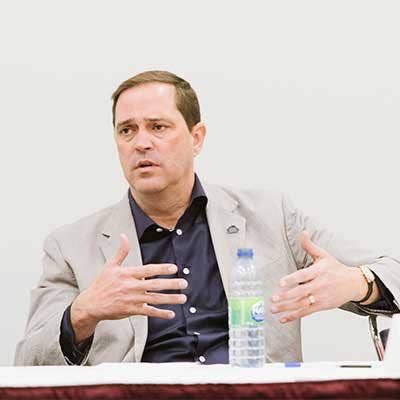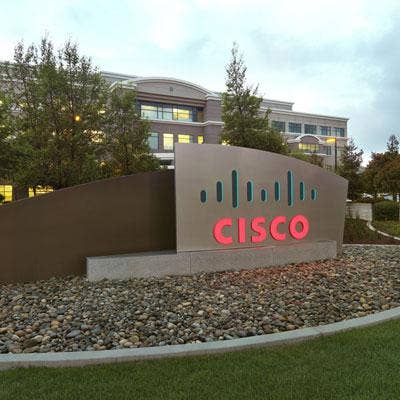The 10 Biggest Cisco Moves In New Robbins Era (So Far)

The Robbins Era Begins
Since Cisco revealed back in May that Chuck Robbins would become the next CEO, the networking giant has been on an executive leadership team overhaul, launched a massive security offense, shut down areas of the company and is striving to become a flatter, more agile organization.
Although just officially starting his new role July 26, Robbins has been making key executive decisions, restructuring the company and ringing in a new vision for Cisco over the past several months.
As his first week as CEO comes to a close, here are the 10 biggest changes we've seen so far in the new Robbins era of Cisco.

Out With The Old, In With The New
Within weeks of revealing Robbins would succeed John Chambers as CEO, Cisco executives Rob Lloyd, president, development and sales, and Gary Moore, president and chief operating officer -- both of whom were seen as front-runners to win Chambers' seat -- left the company. Cisco went so far as to ban both Lloyd and Moore from working at dozens of competing companies like Amazon, Dell and Hewlett-Packard for a year as part of their severance agreements.
Other top executives began to drop like flies. A few days later, it was revealed that CTO Padmasree Warrior, Edzard Overbeek, the company's top services executive, and Wim Elfrink, executive vice president for industry solutions and chief globalization officer, would be leaving. Cisco's global channel chief Bruce Klein also headed for the door.

Robbins Picks 'Next Generation' Leadership Team
Robbins' calls his new 10-person "next generation" leadership team "incredible, with the right blend of experiences, expertise and backgrounds to advance us." The majority of the team consists of current Cisco executives, although many will have new roles. The new face on the team is Dr. Ruba Borno, who will become chief of staff and vice president of growth initiatives, a new position at Cisco.
"I'm extremely confident we will move even faster, innovate like never before, and pull away from the competition," said Robbins in a statement, when his new team was revealed.
Robbins also hired Hewlett-Packard's former top cloud executive, Zorawar Biri Singh, as its new senior vice president and CTO, along with Kevin Bandy as its new chief digital officer, to help define Cisco's next-generation digital strategy. Wendy Bahr, a 15-year Cisco veteran, also was named the new global channel chief.

Cisco Sheds Some Business Lines
Robbins killed off Cisco's ambitions to deliver its own storage technology with the closing of its Invicta Storage Business. Solution providers said Cisco's Invicta business never really got off the ground after the networking giant purchased Whiptail in 2013. Partners think the decision to drop Invicta could mean Robbins is eyeing a hyper-converged acquisition or new OEM agreement.
Cisco also recently sold its set-top Connected Devices business line of video and modem products to French communications and media provider Technicolor for $600 million. Partners believe the deal shows Cisco wants to drop the dead weight and hone in on emerging markets like Internet of Things.

Cisco Becoming A More Open Company
"I see much more emphasis on them clarifying their position around openness and being much more open than ever," said Greg Stemberger, principal solutions architect at Force 3, a Crofton, Md.-based Cisco Gold partner, in an interview with CRN following the Cisco Live training conference in June. "Cisco's got an historic track record of building proprietary solutions ... but I think they're making efforts to improve upon that."
The networking giant has been partnering with a number of security vendors, including Elastica and Lancope, to improve its solutions, while also recently integrating its TrustSec security technology with Lancope. Cisco also extended its virtual machine on-boarding to support Amazon Virtual Private Cloud, as well as its firewall services to now support Microsoft Azure. Intercloud Fabric also now supports OpenStack KVM and Microsoft Hyper-V. In addition, Cisco unveiled 35 new partnerships with ISVs, who will become part of the company's Intercloud ecosystem.

Robbins Changing Sales Team Compensation
Just ahead of being selected as the company's next CEO, Robbins said he would make changes to Cisco's internal sales compensation to increase earnings for direct reps who push more consumption of partner-provided services. Sales reps will have an incentive to sell partner services built on Cisco products.
"We are making changes that will more tightly align our sales organization around the world with, candidly, the consumption changes that we see happening in the marketplace, and will more tightly align to some of the cloud offers and managed services offers that many of you are taking to market so that we can minimize any conflict out in the field," said Robbins during the 2015 Cisco Partner Summit.
"We're tweaking [our sales force's] compensation to recognize not only selling routing and switching products in the Net 30 mode, but also working with the partners," he said.

Acquisitions Tear Continues
Cisco's acquisitions have been heating up as of late. Since Robbins was announced as Chambers' successor, Cisco has revealed four companies it plans to acquire.
In the OpenStack space, Cisco nabbed cloud startup Piston Cloud Computing to accelerate its Intercloud strategy. In the security space, the networking giant is pulling in OpenDNS for $635 million, a provider of advanced threat protection delivered via a Software-as-a-Service model to build upon Cisco's "Security Everywhere" throughout the network strategy.
On the software side, Cisco will buy Tropo, a cloud API platform provider. Cisco also revealed it would snatch up MaintenanceNet, a Carlsbad, Calif.-based developer of cloud-based solutions for handling renewals via channel partners.

Robbins Betting Big On Internet of Things
Cisco bulked up its Internet-of-Things offerings substantially in recent months, setting its sights toward a digital world.
The company launched more than a dozen new IoT products and a new framework aimed at partners to start getting their feet wet in the emerging market. New purpose-built IoT networking products included two IP cameras, an industrial switch, an 802.11ac access point, along with seven new routers designed for rugged environments in manufacturing, transportation, cities and other IoT fields.
Cisco also has unveiled a new Cisco Certified Network Associate Industrial IoT certification to train networking engineers, plant administrators, control engineers and IT engineers to learn how to build, manage and operate converged industrial networks.

The 'Networking Giant' Becoming The New 'Security Giant'
Partners and analysts said Robbins' No. 1 priority right now is security. He even asked Chambers to be the "executive sponsor for security" in order to focus Chambers' efforts around security.
Cisco's current goal is to triple its market share in the enterprise security space from the current 9 percent to upward of 30 percent through acquisitions and partnerships along with new products, services and solutions.

Cisco Investing Billions More Abroad
Robbins and Chambers visited China in June to meet with leaders and government agency officials, unveiling a new $10 billion investment in the country. The billions will be spent in China over the next few years toward a "renewed commitment" and agreements with the Chinese government to expand partnerships, research and investments in "next-generation" Chinese technology.
Robbins also recently announced Cisco will invest $1 billion in the United Kingdom over the next three to five years to boost the country's technology sector, with a focus on the emerging IoT market. Cisco also made an undisclosed amount of investments to Paris-based developer of software-defined networking and network function virtualization, 6Wind, in June as part of its recent commitment to spending $100 million on incubator and accelerator programs in France.

Building A Flatter, Faster, More Agile Cisco
Robbins' key executive decisions thus far are geared around making Cisco a faster, flatter and more agile company.
"Flatter organizations can move faster. So that's what our aspiration is, and we'll continue to work that way in the coming years," said Robbins during a media conference at Cisco Live.
Robbins said in a recent blog post that data -- and the insights collected from that data -- will be the "most strategic asset" in the new digital world.
"The ability to secure, aggregate, automate and draw insights from the data -- with speed -- will ultimately define success," said Robbins. "Only Cisco, and only the network, can deliver the highly secure, distributed, and intelligent infrastructure and solutions required in today’s highly dynamic digital world."